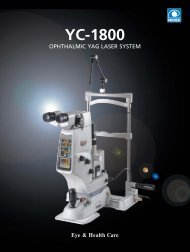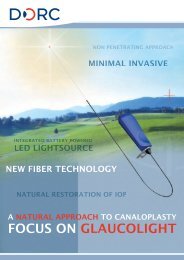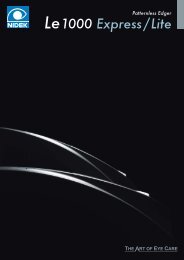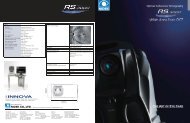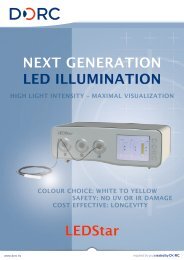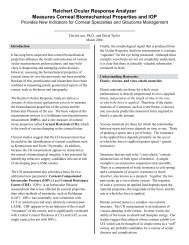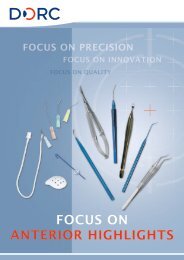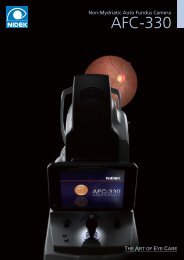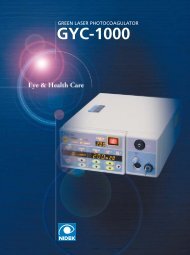ARK-1 / AR-1 - innova
ARK-1 / AR-1 - innova
ARK-1 / AR-1 - innova
You also want an ePaper? Increase the reach of your titles
YUMPU automatically turns print PDFs into web optimized ePapers that Google loves.
The Superior Auto Ref / Keratometerand Auto RefractometerWhat is the superior auto ref / keratometer and auto refractometer?The <strong><strong>AR</strong>K</strong>-1 / <strong>AR</strong>-1 series speak for themselves, surpassing a conventional auto ref/keratometer andauto refractometer with technologically enhanced functions generating greater accuracyand greater clinical information.Superior Functions forSuperior OutcomesAccurate Refraction MeasurementVA Measurement with Glare TestSimple Opacity AssessmentPatient-friendly Accommodation MeasurementModelRefractionmeasurementKeratometrymeasurementVA measurementGlare testOpacityassessmentAccommodationmeasurement<strong><strong>AR</strong>K</strong>-1s<strong><strong>AR</strong>K</strong>-1a<strong><strong>AR</strong>K</strong>-1<strong>AR</strong>-1s<strong>AR</strong>-1a<strong>AR</strong>-1-Available -Not available
Accurate Refraction MeasurementLarge Pupil Zone Imaging MethodThe large pupil zone imaging method enables the measurement of wide area refraction of up to 6 mm diameter andcan indicate the difference between wide area refraction and the central area refraction of up to 3.5 mm diameter. Thepupil diameter is measured simultaneously. The difference of the measurement allows assessment of the effect of pupilsize such as a vision in dim light.ø1 to 4 mm areaø1 to 3.5 mm areaø1 to 6 mm areaRing image<strong><strong>AR</strong>K</strong>-500 / <strong>AR</strong>-300 seriesPupil zone imaging methodRing image<strong><strong>AR</strong>K</strong>-1 / <strong>AR</strong>-1 seriesLarge pupil zone imaging methodSuper Luminescent Diode and Highly Sensitive CCDIncorporation of the Super Luminescent Diode (SLD) provides a sharper and clearer image compared to a conventionalLED. The highly sensitive CCD detects the ring image even if the fundus reflection is weak. The system combining theSLD and highly sensitive CCD significantly improves measurement capability even in dense cataractous eyes.Half mirrorHyperopia Emmetropia MyopiaEyeAstigmatism AstigmatismSimulated ring imageSLD (normal eye)LED (normal eye)ReflectivemirrorRing lensEmitted SLD lightReflected lightRing imageSLDHighly sensitive CCDSLD (cataractous eye)* LED (cataractous eye)*Captured ring image* In-house data of a cataractous model eyeOptimal Fogging to Minimize Accommodation (available for the <strong><strong>AR</strong>K</strong>-1s, <strong><strong>AR</strong>K</strong>-1a, <strong>AR</strong>-1s, and <strong>AR</strong>-1a)Fogging is performed after correcting the patient’s astigmatism with built-in cylinder lenses. This allows the patientto view the target clearly and minimizes the interference with accommodation even in high astigmatism.
VA Measurement with Glare TestVA Measurement with Built-in Charts and Lenses (available for the <strong><strong>AR</strong>K</strong>-1s and <strong>AR</strong>-1s)The <strong><strong>AR</strong>K</strong>-1s / <strong>AR</strong>-1s provides visual acuity (VA) measurement. This unique function enables a quick check of the patient'srefractive error by comparing subjective measurement with objective measurement. Even corrected near visual acuity ismeasurable with easy operability to determine the need for a progressive lens.Recall Function for Instant Vision Comparisons (available for the <strong><strong>AR</strong>K</strong>-1s, <strong><strong>AR</strong>K</strong>-1a, <strong><strong>AR</strong>K</strong>-1, <strong>AR</strong>-1s, and <strong>AR</strong>-1a)The recall function provides the instant comparison between vision corrected with <strong>AR</strong>data and uncorrected vision or vision corrected with the data of patient’s own glasses.For the patient, this function demonstrates the difference in vision and the necessityfor more appropriate vision correction.Distance vision corrected with <strong>AR</strong> data Uncorrected distance visionDistance vision corrected with <strong>AR</strong> data Distance vision corrected with LM data*Near vision corrected with <strong>AR</strong> data Uncorrected near visionNear vision corrected with <strong>AR</strong> data Near vision corrected with LM data*Vision comparisons*The data of patient’s own glasses has to be importedfrom a NIDEK lensmeter.Contrast and Glare Test (available for the <strong><strong>AR</strong>K</strong>-1s and <strong>AR</strong>-1s)After a low contrast VA chart isprojected, a glare source is projectedbeside the chart and the glare VA canbe measured. With this test the effectof glare and halo to visualperformance can be measured. Thisutility can be used for cataract andrefractive surgery patients.Simulated patient’s vision oflow contrast VA chartVision with glare and halo Normal visionSimulated patient vision of VA chart and glare sourceSimple Opacity AssessmentRetroillumination Image and NIDEK Cataract Indices*The retro illumination image enables the observation of opacity of the optical mediaof the eye. NIDEK cataract indices indicate the severity of the opacity and helps toassess the progression of pathology.COI.HOpacity size within a diameter of 3 mm of the center (vertical diameter): mmCOI.A Opacity proportion within a diameter of 3 mm of the center: %Eye with dense opacityPOI Opacity proportion within the entire periphery: %Cataract indices*Available for the <strong><strong>AR</strong>K</strong>-1s, <strong><strong>AR</strong>K</strong>-1a, <strong>AR</strong>-1s, and <strong>AR</strong>-1aThe NIDEK Cataract indices are for reference only.The following conditions may indicate different indices from ones of actual status.Peripheral image is darkly captured due to alignment position.Opacities are not in focus.Bright spot reflecting observation light occurs on the cornea apex.Position of the 3 mm diameter circle is shifted due to incorrect pupil detection caused by opacity location.Eye with light opacity


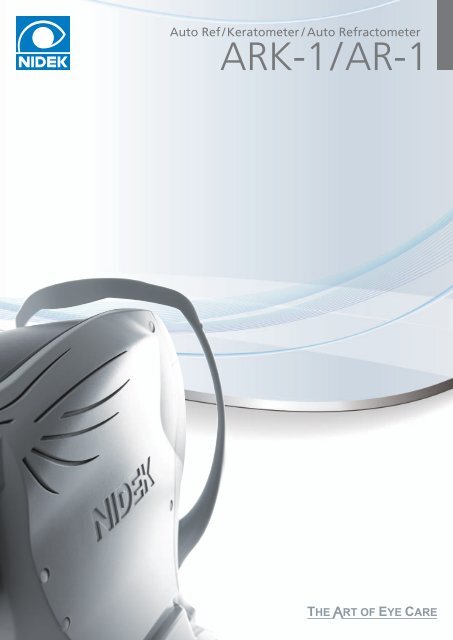
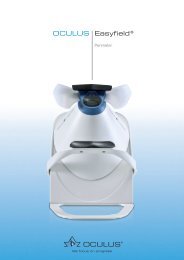
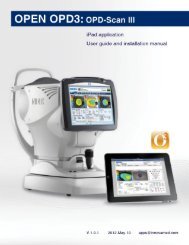
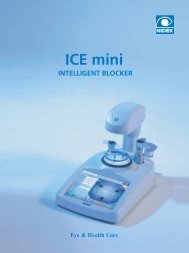
![OCT Setting: CORNEA RADIAL 6( 6.0mm[1024] ) - innova](https://img.yumpu.com/48127738/1/190x146/oct-setting-cornea-radial-6-60mm1024-innova.jpg?quality=85)
